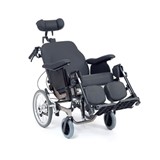The worms are bound for the International Space Station (ISS) where they will experience the same weightless conditions which can cause dramatic muscle loss in astronauts. The research will be carried out onboard the ISS in the Japanese Experiment Module known as ‘Kibo’.
Dr Nathaniel Szewczyk, from the University’s Institute of Clinical Research in Derby, studies the signals that control muscle protein degradation. His work centres on the microscopic worm, Caenorhabditis elegans (C. elegans). These worms are the perfect substitute for studying long term changes in human physiology because they suffer from muscle atrophy – muscle loss – under many of the same conditions that people do.
Muscle atrophy is one of the major health concerns for astronauts but this research will also help scientists understand more about the condition which also affects the bedridden, people with muscular dystrophy and diabetes, people immobilised by casts and the elderly.
Dr Szewczyk is no stranger to space flight. This will be his fourth space worm mission. This month’s reservation has been negotiated through the Japan Aerospace and Exploration Agency (JAXA).
The Nottingham scientists will be working in collaboration with Professor Atsushi Higashitani from Tohoku University, Sendai, Japan. Professor Higashitani is the Principal Investigator of the CERISE (C. Elegans RNAi In Space Experiment) payload and will be based in Florida for the duration of the flight to co-ordinate all aspects of the running of the payload’s experiments.
Dr Szewczyk said: ”The CERISE payload is an important space medicine experiment as it will establish if RNAi, which was the subject of the 2006 Nobel Prize in Medicine, is a viable technique for altering the biological response to spaceflight. For example, some of our worms will be treated with RNAi against specific proteases to see if we can stop muscle protein degradation in space.
“However, this is just one of many experimental conditions that Atsushi will be overseeing and I can’t say enough how grateful I am that Atsushi is dealing with the myriad of problems and paperwork that come with managing any spaceflight experiment.”
The C. elegans was the first multi-cellular organism to have its genetic structure completely mapped and many of its 20,000 genes perform the same functions as those in humans. Two thousand of these genes have a role in promoting muscle function and 50 to 60 per cent of these have very obvious human counterparts.
His researcher Dr Tim Etheridge has been given the task of preparing the worms for their journey to the International Space Station, which is roughly 200 miles from the Earth. The worms have been carefully selected and brought to a dormant state for the journey.
They will be travelling in special cell culture bags and will be brought back from their dormant state with the release of food. They will be exposed to conditions in space for four days before being frozen in preparation for the return journey. The effect of this journey on their muscle mass will be investigated once the worms are returned to the University’s laboratories in Derby.
The Kibo lab makes use of the weightless conditions experienced in orbit for the study of biomedicine and material sciences. The University of Nottingham experiment will be part of the Japanese CERISE payload and is being funded as part of a $1m (£0.6m) United States National Institute of Health grant to investigate the genetic basis of muscle atrophy and the Medical Research Council.
Biological experiments in space need life support – oxygen, temperature control and pressure – so competition for space on manned flights is fierce and in short supply.
Dr Szewczyk said: “We can learn things in space that we would not be able to learn on earth. If we can identify what causes the body to react in certain ways in space we establish new pathways for research back on earth.”
The Space Shuttle Atlantis is due to take off from Launch Pad 39A at the Kennedy Space Centre at 2.28pm local time on November 16, 2009. Both Dr Szewczyk and Dr Etheridge will be travelling to Florida to see the worms safely onboard the space shuttle.
The origins of Dr Szewczyk’s worms can be traced back to a rubbish dump in Bristol. C. elegans often feed on bacteria that develop on decaying vegetable matter. In space they will be fed bacteria that have been heat inactivated.
Dr Szewczyk’s C. elegans made news in 2003 when they survived the Space Shuttle Columbia disaster. Living in petri dishes and enclosed in aluminium canisters the worms survived re-entry and impact on the ground and were recovered weeks after the disaster.
Space flight research poses two big problems – access and money. Securing a place onboard the international space station is not only expensive it is also an exercise in diplomacy and international politics. It might not come up with as many direct answers as research carried out on Earth but Dr Szewczyk argues that space flight research is a unique opportunity to put life in difficult conditions and learn something fundamental about it. He also thinks that the work is a great way to get school children excited about science. He is working with Orion’s quest to involve primary school children in this experiment.



